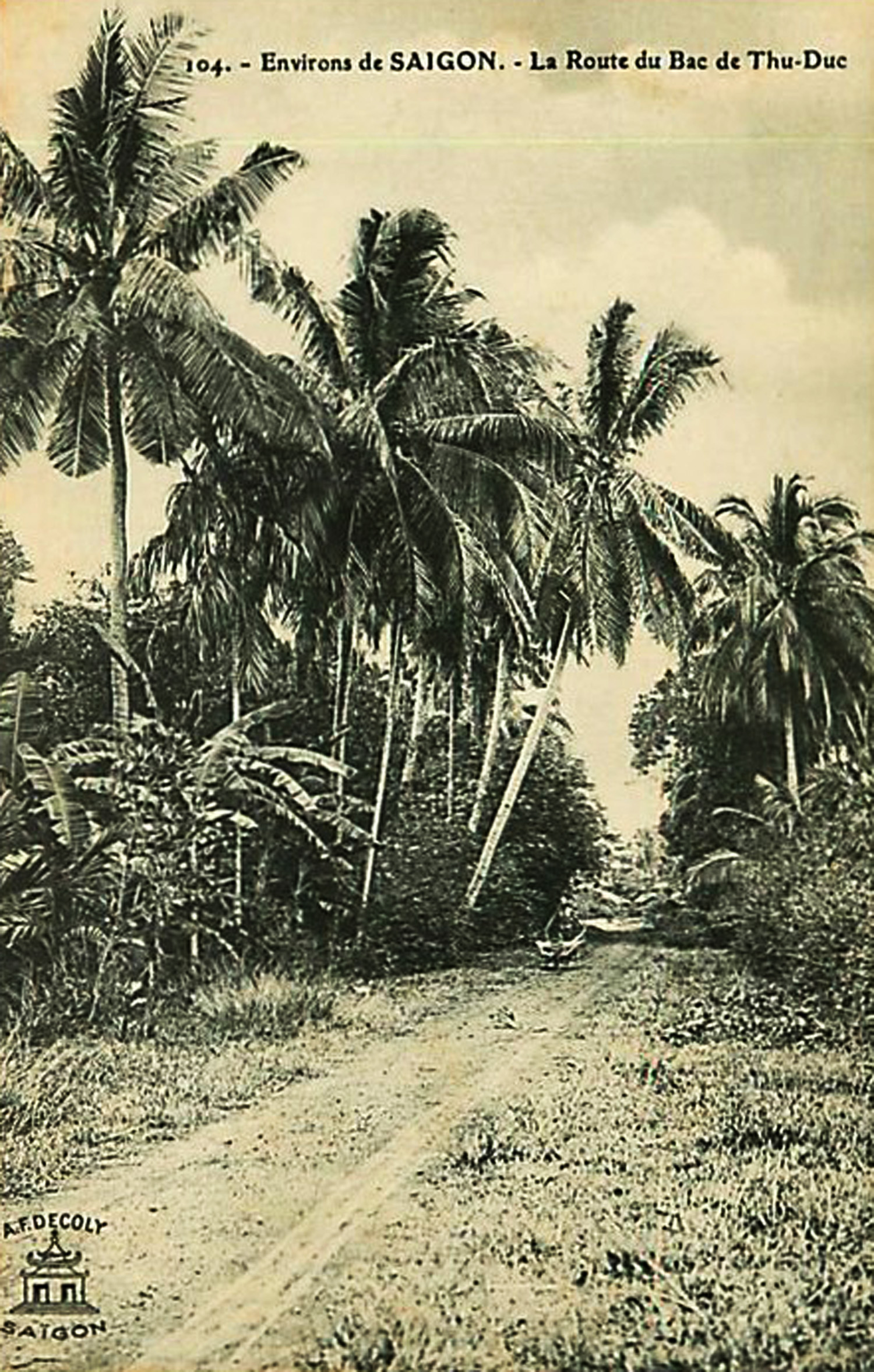
During her last few days in Saigon, Louise Bourbonnaud set out on an excursion to Thủ Đức
In mid 1888, wealthy French widow Louise Bourbonnaud set off alone on an extended voyage of discovery which took in India, Ceylon (Sri Lanka), Singapore, Cochinchina, China and Japan. She spent over a week in Saigon and her 1892 book Les Indes et l’Extrême Orient, impressions de voyage d’une parisienne provides us with a fascinating, if somewhat condescending, account of late 19th century colonial life. This is the fifth and final instalment from her book, translated into English.
To read part 1 of this serialisation click here.
To read part 2 of this serialisation click here
To read part 3 of this serialisation click here
To read part 4 of this serialisation click here
Friday 31 August 1888
Today I’ll go on a serious excursion to a place called Thu-Duc, or île des Cocotiers (Coconut palm island). This is no small matter, because there is a river to cross – without a bridge, of course!
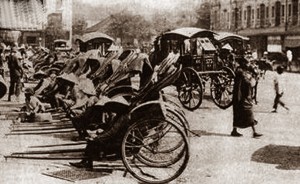
Malabar and pousse-pousse drivers wait for customers
The first challenge is to find a driver who will condescend to take me. I have such a reputation here, they know me so well for my bravery and endurance to fatigue that I seem to frighten even the bravest driver away. But, thanks to the owner of the hotel, I finally find a carriage and, after a long discussion, I agree to pay the driver 2 piastres for the trip. The river crossing will be paid for separately and will be my own responsibility, of course; that is part of the expenses of my expedition!
The journey gets under way and we soon arrive at the edge of the Cambodia river that must be crossed. There is no bridge, I repeat, between its banks, and the waters run furious and thundering. From time to time, large trees float by that may have come from very far upstream; they roll over, extending their branches towards the sky like drowning men calling for help. And then I discover that we will cross this river on a meagre raft whose poor boards creak and groan and constantly seem to be in danger of coming apart from each other!
My coachman, with typical oriental fatalism, does not seem too worried by the situation. After he has parked his carriage, he takes off the few clothes he was wearing, and then – as nude as a worm and not looking the best for it, I assure you – he disconnects his horse and, with the help of a passer-by, pushes the carriage onto the raft. Finally, he leads his horse and me onto the raft – which then leaves the safety of the riverbank, carrying Madame Bourbonnaud and her fortune!
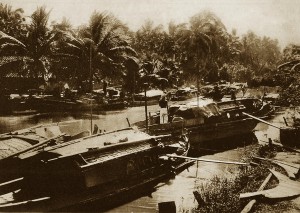
The river at Thủ Đức
The crossing is accomplished without incident and we soon land on the île des Cocotiers. This perilous passage reminds me a little of crossing the rivers in America.
The landscape is very pretty; after two minutes walking among the trees, we come to a charming fountain where water gurgles into a pool. I am told that this is where French people come to bathe on Sundays. Not far away, on the road, is a café-restaurant. Today there are no Europeans on this side of the river, only local people. All of them – men, women and children – chew betel, which gives them a very nasty mouth.
As I bravely walk alone through the Annamite village, I hear a terrible clap of thunder. Lightning streaks the sky on all sides and heavy rain begins to soak me from head to toe.
I immediately remember that I must get out from under the trees, because they attract lightning. The sky is invisible, obscured by the heavy rain which falls in sheets, making it impossible to see beyond a radius of a few metres. What a horrible time! I’m in big trouble!
I decide that I must get out of here quickly and take the path which leads back to where my carriage is parked. The path is narrow and at one point it descends into a basin which has already filled with water. Rolling up my dress and petticoat, I wade courageously through it; as for the boots below, it’s no longer worth worrying about, because the water is now up to my knees!
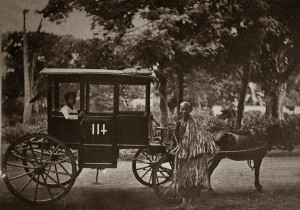
A waiting Malabar
To make matters worse, the tall grass on either side of the path attaches itself to my clothes and seems to want to prevent my passage. A thousand small spikes scratch my legs; my dress and my petticoat is filled with wet foliage; it will take me at least a day to remove it all!
Another path crosses the one that we have taken, my Annamite driver and I; this one is even more flooded than the first and by now it is awash with muddy waves. An old piece of board, worm-eaten and slippery, will serve us as a bridge; the driver holds out his hand and helps me step onto it. Fortunately I have sailor’s feet and I’m soon on the other side of the inundation. There’s the carriage! I slip inside and await the end of the thunderstorm. I don’t think there are many women who have the courage to do what I did back there, to expose myself alone in the middle of this wild country; I might well not have made it back!
I’m safe at last, but in what condition! Soaked to the bone, with not a dry thread on me. After the storm has subsided, we re-cross the river without incident and return to Saigon, where I am happy finally to change my clothes back at the hotel. It’s stopped raining now, but the weather is overcast and the sun is nowhere to be seen.
On the return journey, I pass some zébus, small humpback cattle that local people lead by a rope passed through the nose of the animal. The calves follow their mothers, which they suckle from behind.
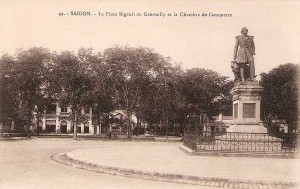
Place Rigault de Genouilly (Mê Linh square) and the Chambre de commerce building
Once I’ve changed, I feel more at ease and I’m ready to start again; fatigue and danger cannot scare me. The good rain this morning is cause for rejoicing amongst the local population, because there will be no shortage of water in the rice fields and this is a good omen for the future harvest. At times of drought, Chinese and Annamite make processions in the streets to beg the heavens for water.
Every day at noon, a cannon sounds – it’s like the one near the Eiffel Tower – and everyone can set their watch by the time which has thus been officially given.
In the garden, not far from the hotel [modern Mê Linh square], opposite the statue of Admiral Rigault de Genouilly, is a high pyramid in memory of Mr Navaillé, a prominent citizen who did much for the development of trade in Saigon and the colony. The cost of this monument was met by subscription.
Many Europeans who come here are naturally curious to know more about indigenous customs. Some try to chew betel and others to smoke opium; the latter is very dangerous and can produce serious disturbances to the health of the one who uses it immoderately. Moreover, Chinese and Annamite only smoke opium in very small quantities: a little chandoo is picked up on the end of a knitting needle and placed in the bowl of the pipe.
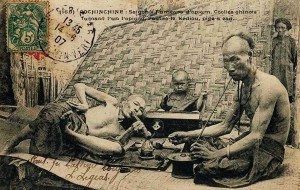
Chinese opium smokers
After the smoker has taken a puff or two, the pipe is finished. He who succombs to opium addiction is a lost man, because he is fatally driven to continue smoking and death is not slow to arrive; it should be noted, however, that the Chinese have longer resistance to intoxication.
There is also another kind of pipe, which takes the form of a box containing water, through which the smoke passes before reaching the smoker’s mouth; it is said that this system has the effect of making the smoke less harmful to the smoker’s health.
At that moment, another Chinese woman passes beneath my window; despite the fact that her costume is identical to that of a man, I’m sure it’s a woman, because from her shape I guess that it will not be long before she gives birth!
When one wants to speak a Chinese or Annamite word, one must be very careful to emphasis the first syllable and pronounce each syllable separately: thus, Annam is pronounced: “An-nam;” and Pholong is pronounced “Pho-long.”
Saturday 1 September 1888
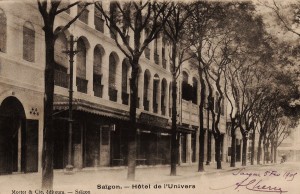
During her visit, Louise Bourbonnaud stayed at the Hôtel de l’Univers
Today it pours with rain all day; at first, I don’t bother to get dressed but stay in my room to write. What a strange life they lead, here in the colonies! You spend your time dressing and undressing; me, I could never get used to the life here, especially since the colons very rarely walk anywhere; it seems that they can’t go two steps without taking a carriage. That would be difficult for me, I need the exercise! I need to walk, give me movement!
And in particular, I could never become accustomed to the siesta.
Get up early, I am told, and rest during the heat of the day; the sun here is very dangerous and you risk a lot if you try to brave it.
This counsel can be good, I reply, but it is still not fully light by 7am and at 5pm night begins to fall. Anyway, I cannot sleep in the daytime. With so little time to visit Cochinchina, if I spend my days sleeping, I will leave without having seen anything!
No, here the colons certainly lead a lazy life, and it could very well be shaken up a bit; not least the fact that the clothes they wear could be lighter and more suited to the climate.
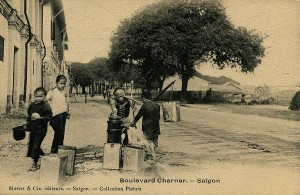
Boulevard Charner (Nguyễn Huệ boulevard) in Saigon
Later, I hear a knock at my door; It’s Mr R, a merchant in the colony who also does business in Cambodia and whom I had the pleasure of meeting at Mr de Blainville’s house. He has come to visit me and I invite him up to join me on my verandah. For nearly two hours, we talk in a friendly way about this and that, but mostly about the manners and customs of this country. Mr R knows a lot on this subject, as he has lived here for some time.
Before lunch, I go for a walk in town and buy a Chinese sword decorated with coins; then, in the shop of another merchant, I buy two beautiful silk scarves, with birds and. flowers embroidered on a red background. I also purchase a Chinese doll for little Martha de Blainville. I will give her this present when I leave Saigon; I also want to give to her sister, Miss Adele de Blainville, the model carriage that I bought in Singapore on my way here; I’ll buy another one on my return journey to France.
I stop to talk to the owner of the hotel, who tells me that he plans to retire in a few years, but not before having saved enough money to live comfortably on his pension. He wants to return to Paris, but he no longer wants to be involved in business there. He says that the businessmen of Paris are a bunch of rascals who would not fail to exploit him and gobble up the little money that he has earned in the colonies!
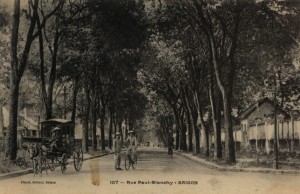
Rue Paul Blanchy (Hai Bà Trưng street) in Saigon
It is 4pm; today I want to go to bid farewell to Mr de Blainville, because tomorrow is Sunday and I’m afraid that none of my honourable friends will be at home as they will probably be out enjoying an excursion; I would also like to offer my small gifts to the young ladies.
At the moment I leave the hotel, I hear the joyous fanfares of a military band resounding through the streets. Today a ship has arrived bringing French troops; some of them will remain here, while the rest will be sent to Tonkin.
The rain begins to fall – again! This is decidedly too much! Much too much! And even if it means that the rice fields will fill with water, it is not pleasant for me. I get out of my carriage at the residence of Mr de Blainville, who comes out to meet me with his whole family. I say goodbye to these caring friends who have welcomed me so kindly and – alas! – I will never see them again! I learn later that almost the entire family fell victim to the climate of the colony.
I myself feel a little tired, and it is now time for a change of scenery, so I plan to do a rapid tour of China and Japan.
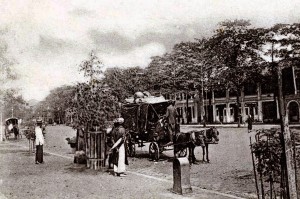
Another Malabar driver waits for customers
Taking leave of my friends, after a visit which is naturally prolonged, I cannot find my carriage at the door! The driver, probably tired of waiting in the rain, went to take cover, and I am forced to find another carriage to take me back to the hotel.
After dinner, Mr R meets me and accompanies me on another trip to Cholon, or Cho- lon as the local people say, separating the two syllables. I do not think that it is very prudent for a woman to venture alone on that side of town after dark, but thanks to the kindness of my compatriot, I can enjoy a spectacle worth seeing.
Cholon, viewed in the evening, offers a different appearance than it does during the daytime. The animation is the same, even greater perhaps; all the vendors display their goods on counters outside their shops, or on stalls outside their doors, according to the nature of the objects offered for sale. Everything is illuminated by lanterns of strange shapes and the most varied colours; it is magical and charming, especially when viewed from afar.
We enter the Annamite Theatre. A dozen performers are there, sitting on stools, whining, crying, screaming; one cannot distinguish any song amongst the horrible noise they make; their bodies are dripping with oil, grease, soot and other things. For costumes, they have only rags, and as for the play being presented, it is not possible to grasp anything. Around 50 local spectators are sitting in a room which is sparingly lit by a few meagre lanterns.
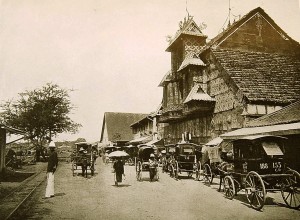
The Annamite Theatre in Cholon
It’s not beautiful, but when you travel, you have to see and learn about everything, if you want to be able to tell people about it later.
Afterwards, for variety, we go to the Chinese Theatre.
What a good time we have there! This place is much better, even though it looks nothing – even from afar – like the Opéra or the Comédie-Française; but with its exotic nature, it is truly not too bad.
Firstly, we pay nothing to enter, which is charming isn’t it? It seems that wealthy Chinese people maintain this theatre at their own expense, and pay courtesy to Europeans by offering them free admission. I do not believe that the Parisian theatres are similarly kind to the Chinese!
We take our places in the gallery on the first floor, seated on simple wooden benches, not padded at all. The pit extends below us; about 300 Chinese flock there, some bare-chested, others a little more dressed; many are smoking opium.
The orchestra is located behind the actors. The musicians are few, but they make a lot of noise, which compensates.
There is no curtain; the actors are separated from the spectators by an opening that brings to mind that of the puppet theatre.
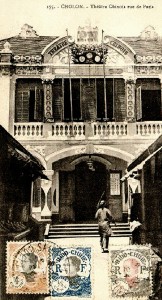
The Chinese Theatre in Cholon
The costumes are very rich, some embroidered with gold and silver, and apparently worth a great deal of money. I saw one costume which they told me was worth around 6,000 francs; at least, that’s the price we’d pay for it in Paris.
As for the subject of the piece, it is quite difficult to take in when you don’t understand a word of the dialogue. However, this is not like the Annamite theatre: it features a rather expressive pantomime, which lasts for some time, by the way. As always, the female roles are played by men wearing female costumes.
When I first enter the auditorium, I see two characters on the stage: The seated one is dressed in Chinese style, wears a white wig and a sort of diadem on his head and carries a spear in his hand. Next to him stands a man wearing a huge hat with several cornets gaudily bedecked with gold and silver trimmings. I get the impression that the second scolds the first; then they seem to agree and sing a song together: a love duet probably, or maybe something else. Thereupon arrive two masked individuals, who appear angry at the first two. The action then continues for I do not know how long, all the while not seeming much more explicit.
When one of the players has finished, he rests behind the small gallery where the musicians are located and waits there, without evading the eyes of the audience, until it is time for him to go back on stage. This perceived invisibility of characters who are momentarily away from the action shows us that the Chinese do not have the same ideas as us.
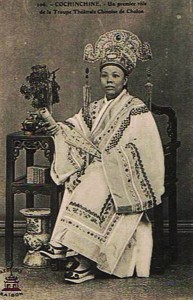
A Chinese opera performer in Cholon
I take away from my evening in the theatres of Cholon the best memories, for which I am indebted to my friendly and accommodating host.
When we begin our journey back to Saigon, it seems that the moon has not yet risen, or perhaps it is just very overcast. Leaving the brightly-lit streets of Cholon, we suddenly find ourselves in pitch darkness. The driver can no longer see the road and a bit further on, the horse, carriage and passengers almost take an accidental dip in the arroyo [the Bến Nghé creek]. Fortunately we stop, just in time!
Cholon is like a little Venice….there are canals and waterways that flow in every direction. I was once told that that if you come by boat from the sea without a pilot, you could very well not even find Saigon and, travelling from arroyo to arroyo, return to the sea without ever seeing the city; I have no difficulty in believing it!
I must confess that, after that incident, I keep a close eye on the driver to check our progress. Mr R, to whom I extend my thanks for treating me to a lovely evening, takes leave of me by praising the unflinching courage I showed earlier in the face of an involuntary bath.
Sunday 2 September 1888
This morning I’m in a bookstore, where I buy some newspapers, and from there I head to the Post Office. But it ‘s 9am and the Post Office is closed. Also closed, the Cathedral! I wait for two hours, reading my newspaper, but to no avail! The church does not open: Ite missa est! And I have nowhere else to go.

Saigon Cathedral in the 1880s
Strange, it seems to me that last Sunday I didn’t arrive any earlier. Anyway, I don’t waste any more time thinking about it, and begin to walk towards the Cercle des Officiers [now the District 1 People’s Committee building]. Suddenly, at full speed, a light carriage arrives, driven by an officer who greets me graciously. At first I think that he may have mistaken me for someone else, but not at all; the horses stop.
“Madame Bourbonnaud! Ah! what a happy coincidence!”
I turn around, surprised. “Dr Maheau! How can you be here?
I am surprised to recognise one of the most amiable army doctors who accompanied me two years ago on a journey in Mexico. I notice on his chest a red ribbon that was not there during our last meeting and I warmly congratulate the happy doctor on this well-deserved distinction.
“How I regret, my dear Madame, not having known of your presence here! I would have come to see you earlier. But, with your permission, I intend to make up for that!”
“Sadly, there won’t be time for that. I’m leaving tomorrow.”
“For Tonkin?”
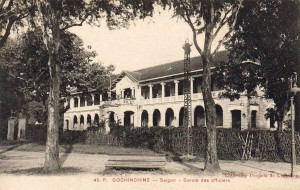
The Cercle des officiers
“No, but I didn’t want to come to Saigon without also making a trip to China and Japan. I simply wish to be able to say that I saw the Middle Kingdom and the Empire of the Rising Sun, because my intention is not to stay long in these parts.”
Dr Maheau is in a hurry and we take our leave of each other, though not without cordially and repeatedly shaking hands. It’s funny, all the same, to meet acquaintances so far from one’s home country! It is true that in the colonies this is not uncommon, especially when, like me, you have already travelled so much.
On returning to the hotel, I feel ill at ease. Has the heat and humidity, maintained by the continuous rain, finally taken its toll on my courage and resistance to fatigue? It is perhaps inevitable that the new environment would eventually leave me feeling a little disorientated. Perhaps the good sea air on the next leg of my voyage will do me good. After careful reflection, I decide not to take my daily bath. It would be imprudent to do so, and in these lands, imprudence can be costly!
But I have great difficulty staying in one place. I need activity! So this afternoon I go once again by Malabar to hear “la musique.”
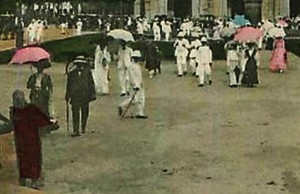
Colons dressed in their Sunday best
The society in attendance is the same as it was last Sunday. The crowd in full dress arrives in carriages or on foot around our little troopers, who play the most charming pieces from their repertoire. What a difference, between these harmonious chords and the horrible cacophony I heard yesterday evening at the native theatres of Cholon!
The ship which will convey me has arrived. I only have a few more hours to spend in our beautiful colony, because on my way back I do not intend to come ashore here. I will return non-stop from Yokohama to Marseille.
Tim Doling is the author of the guidebook Exploring Saigon-Chợ Lớn – Vanishing heritage of Hồ Chí Minh City (Nhà Xuất Bản Thế Giới, Hà Nội, 2019)
A full index of all Tim’s blog articles since November 2013 is now available here.
Join the Facebook group pages Saigon-Chợ Lớn Then & Now to see historic photographs juxtaposed with new ones taken in the same locations, and Đài Quan sát Di sản Sài Gòn – Saigon Heritage Observatory for up-to-date information on conservation issues in Saigon and Chợ Lớn.

